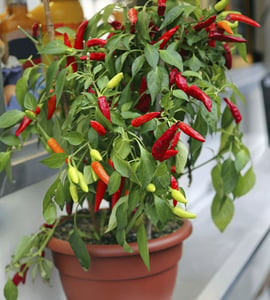Growing Chillies in the Greenhouse Advice
Written by John Harrison on 19th Jan 2016.
Choose Your Chilli Varieties Carefully

We're all tempted to grow the extremes, the biggest or most flavourful and with chilli peppers, the hottest. But do think it through, there's little point in putting a lot of effort into growing a pepper that is so hot you can't actually use it. A milder variety means you can add flavour as well as heat to a dish where even one of the super-hot chillies can be too hot to taste and just makes the dish hot.
Long Growing Season
The secret to a good crop of chillies is a long, hot growing season. This is why they're usually best grown in a greenhouse. You can grow them outdoors but the British summer is variable to put it mildly and a glass or polycarbonate greenhouse is much more reliable.
When and How to Sow Chilli Peppers
Start your chillies by sowing in early February in a heated propagator set to 20 to 24 degrees C. Ideally in the greenhouse but if you don't have power to the greenhouse, start them indoors on a sunny, south-facing window sill.
Sow your seeds individually in 2.5 cm pots or 15 to a tray modules filled with a multi-purpose compost mixed with a fifth by volume of perlite or vermiculite. Just drop a seed on the surface and cover with a little perlite, then water in gently with warm (20 to 24 degrees C) using a very fine rose on the can.
Handling Small Seeds
Tip: sowing small seeds individually can be difficult. Use a plastic dibber or even a pencil with a wet end to pick them up. I just lick the pencil but it's probably bad for you so I'd best not suggest it!
Growing On
Germination is usually a week to 10 days, wait until the seedling has small leaves and then transplant into 7.5 cm or 10 cm pots of multi-purpose compost.
Water in using water at the propagator temperature to avoid shocking the seedlings. Start gradually reducing the temperature, hardening off the seedlings to the greenhouse temperature which ideally will be around 15 degrees C or more.
After a week, keep checking the bottom of the pot and as soon as you see roots starting to poke through the holes in the base, transplant again into their final place. I prefer 20 cm or 24 cm pots but you can plant two to a standard grow-bag if you prefer.
Cultivation
Support the plant with two or three short canes in the pot or bag to stop them falling over, especially when they are laden with fruits later. Pinch out the main stem when it is about 30 to 40 cm high to encourage lots of side shoots to develop.
Water as required but avoid waterlogging.
After six weeks, or when flowers appear if sooner, feed with a general purpose fertiliser such as Miracle Gro and thereafter feed with a tomato feed every two weeks. If the plant loses condition and especially if the leaves yellow, revert to a general purpose liquid fertiliser for a feed or two.
Harvesting
Once the fruits mature and colour, snip them off with secateurs or sharp scissors, leaving the immature fruits to develop.
Pests and Problems
So long as the plants are warm enough, fed and watered they are remarkably easy to grow and trouble free.
Whitefly & Aphids
Sometimes they can be bothered by whitefly, most usually caught from other plants in the greenhouse like tomatoes and aubergines. Yellow sticky cards will control minor infestations but for serious aphid problems consider a spray (approved for food crops) or a biological control – Encarsia formosa.